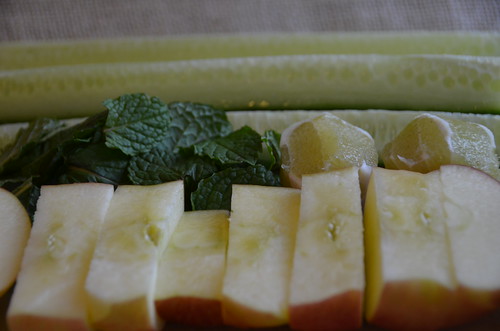The nutrient content of fruits and vegetables is intensified by drinking them in the form of pure juices. These juices will provide the building blocks your body needs. Do some research on the advantages that you can receive from different types of juices prior to beginning a juicing regimen. That way, you can determine which juices can best help you achieve your personal objectives. This article provides several excellent tips about juicing.
Leafy Greens
Cucumber is a great juicing add-on for dark leafy greens. Many dark, leafy greens taste very strong when raw. A bit of cucumber can add a light refreshing taste that will improve the flavor of the leafy greens. Cucumber is also full of important nutrients, especially if you use the unpeeled vegetable.
If you juice dark, leafy greens like spinach, add some cucumber. Most leafy greens have a strong, sometimes unpleasant flavor. Cucumber will put a nice twist on your drink, as well as masking the taste of unpleasant veggies. In addition, cucumber has vital nutrients and the peel should be left on.
Consider you juice to be a whole meal. After you have done this several times, you will find out how much food is needed for one cup of juice, and you will start to realize how effective this can be. If you drink your juice by itself, your body will absorb its nutrients more quickly.
Let color guide you. Each vegetable or fruit juice color, from orange to red to purple, supplies the body with different vitamins and nutrients. These differences offer a well-rounded and balanced nutrition plan, along with a myriad of tastes.
After you have completed your juicing, immediately wash all the equipment that you used. The inherent qualities of some ingredients can also leave stains on the various elements of your juicer.
Let color guide you. Ranging from the vibrant greens to the beautiful bright reds, all these different colors of fruits and vegetables contain different minerals and nutrients. These differences offer a well-rounded and balanced nutrition plan, along with a myriad of tastes.
If your children do not like to eat vegetables because of their look or taste, try juicing them. A lot of children neglect to eat their vegetables. When you mix vegetables in with fruits in a juice, it’ll taste delicious, and kids will have no idea that they’re drinking up vegetables.
Always keep your juicer in plain view on your counter. That way, you will use it regularly. By keeping it visible at all times, you will be more likely to use it.
If you do not want your juice to contain pulp, you can eliminate it by using a coffee filter. Only use a filter, of course, if you find the pulp unpleasant and would prefer it not be in your juice. You can always strain the juice using a cheesecloth; this will get rid of a lot of the pulp.
You should always wash your juicer as soon as you are done using it. Additionally, the juice from some fruits and vegetables can stain juicer jugs and blades.
10 Minutes
Choose a juicer that you can easily take apart and clean. If it’s 10 minutes to put together the juicer, another 10 minutes for using it to make juice, and 15 minutes for cleaning it after that, you may not want to juice! Make sure to clean your juicer soon after you’ve finished with it, as pulp can stick to your juicer and harden, making cleaning more difficult.
As was mentioned earlier, drinking fresh vegetable and fruit juices is a great way to improve your health. If you follow a regular, detailed juicing regimen, you can see dramatic improvement in your fitness and overall health.
Many people want to stockpile juice in the refrigerator, but be sure you guard against pigment changes. Grayish juice isn’t very appetizing! To counter this problem, fortify the juice with two teaspoons of lemon juice. The lemon juice will help the juice retain its bright color, and it will not significantly alter the flavor.
